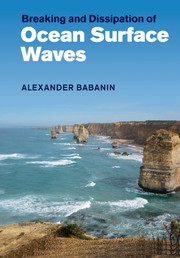Book contents
- Frontmatter
- Contents
- Preface
- 1 Introduction
- 2 Definitions for wave breaking
- 3 Detection and measurement of wave breaking
- 4 Fully nonlinear analytical theories for surface waves and numerical simulations of wave breaking
- 5 Wave-breaking probability
- 6 Wave-breaking severity
- 7 Energy dissipation across the wave spectrum
- 8 Non-dissipative effects of breaking on the wave field
- 9 Role of wave breaking in the air–sea interaction
- 10 Conclusions. What else do we need to know about wave breaking?
- References
- Index
8 - Non-dissipative effects of breaking on the wave field
Published online by Cambridge University Press: 25 October 2011
- Frontmatter
- Contents
- Preface
- 1 Introduction
- 2 Definitions for wave breaking
- 3 Detection and measurement of wave breaking
- 4 Fully nonlinear analytical theories for surface waves and numerical simulations of wave breaking
- 5 Wave-breaking probability
- 6 Wave-breaking severity
- 7 Energy dissipation across the wave spectrum
- 8 Non-dissipative effects of breaking on the wave field
- 9 Role of wave breaking in the air–sea interaction
- 10 Conclusions. What else do we need to know about wave breaking?
- References
- Index
Summary
One of the main roles of wave breaking in the ocean-wave fields is providing the dissipation sink of wave energy (see Chapters 1 and 7). The waves do not grow unlimited in height, and breaking is the main process which restricts this growth even in conditions of continuous wind-energy input over unlimited wave fetches.
Being the loss from the wave system, the breaking dissipation provides a link for the wind-generated waves with other phenomena in the lower atmosphere, upper ocean and on the ocean interface itself. It is a source of energy and momentum for infra-gravity waves, near-surface currents, upper-ocean mixing and the atmospheric boundary layer (e.g. and The WISE Group, 2007).
Some features and physical processes in the air–sea system, related to the breaking, however, are not necessarily of dissipative nature or can be described in terms of the wave-energy dissipation as such, and these are the phenomena to which the current chapter will be dedicated. Some of them have already been mentioned or discussed throughout the book. It was needed and essential to highlight them in order to understand the described features of breaking and whitecapping dissipation.
Others, for example, the spectral-peak downshift which is the topic of the next section, 8.1, have been mentioned as those which contribute to spectral dissipation (see Section 7.3.1). There is no contradiction here.
- Type
- Chapter
- Information
- Breaking and Dissipation of Ocean Surface Waves , pp. 322 - 349Publisher: Cambridge University PressPrint publication year: 2011



